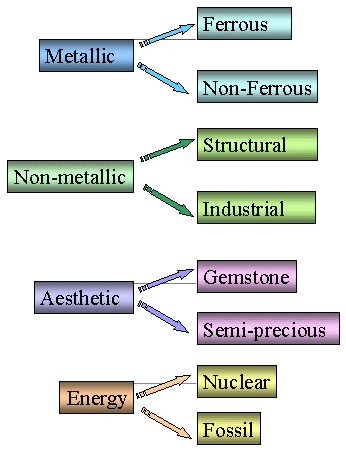| Minerals and Their Use | |
|
In developed countries, as in the UK, people's lives are highly dependent on the mineral resources that are extracted from the earth. Minerals provide the construction materials for where we work and live and contribute to the infrastructure in the form of roads and railways etc. In addition they provide the energy needed to heat houses and drive industry. Minerals can be divided into a number of broad and informal groups (figure 1), defined by their industrial use. Historically metallic minerals for example have been divided into ferrous (iron and related metals) and non-ferrous (gold, copper, etc) groups. This is partly due to the important role that iron plays in the manufacture of steel, which is central to the economy of many of the developed countries. | |

Figure 1:Mineral Groups |
Non-metals are divided into those used for structural purposes such as sand and gravel, and industrial materials that includes minerals used in the manufacture of fertilisers, cosmetics, paper, carpets, communication equipment and a vast range of other items.
The aesthetic group simply indicates those stones whose appearance and sometimes-cultural background increases their value. Finally the energy minerals can be separated into those containing radioactive elements such as Thorium and Uranium or the fossil fuel resources coal and lignite, in addition oil and natural gas are often included in this group. Minerals are formed through specific geological conditions, i.e. particular elements/ minerals concentrate under certain conditions, and thus different mineral deposits are scattered across the geography of the planet. Some minerals are ubiquitous (common) and fairly evenly distributed whilst others are restricted to particular areas of localised abundance. |